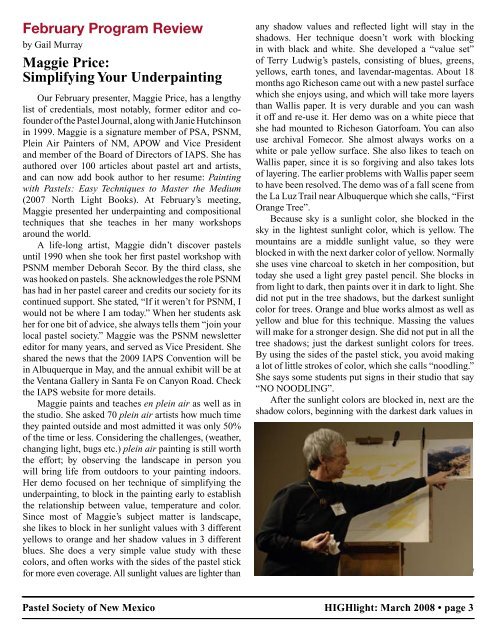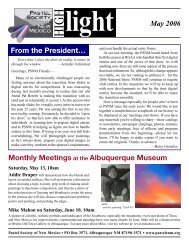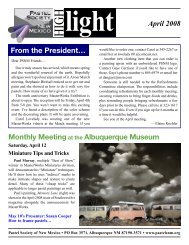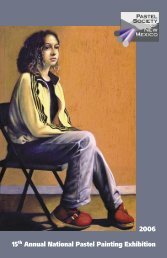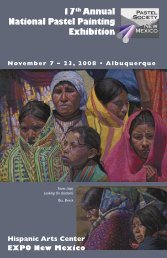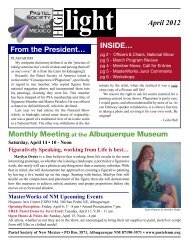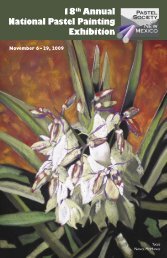March 2008 Highlight - Pastel Society of New Mexico
March 2008 Highlight - Pastel Society of New Mexico
March 2008 Highlight - Pastel Society of New Mexico
You also want an ePaper? Increase the reach of your titles
YUMPU automatically turns print PDFs into web optimized ePapers that Google loves.
February Program Review<br />
by Gail Murray<br />
Maggie Price:<br />
Simplifying Your Underpainting<br />
Our February presenter, Maggie Price, has a lengthy<br />
list <strong>of</strong> credentials, most notably, former editor and c<strong>of</strong>ounder<br />
<strong>of</strong> the <strong>Pastel</strong> Journal, along with Janie Hutchinson<br />
in 1999. Maggie is a signature member <strong>of</strong> PSA, PSNM,<br />
Plein Air Painters <strong>of</strong> NM, APOW and Vice President<br />
and member <strong>of</strong> the Board <strong>of</strong> Directors <strong>of</strong> IAPS. She has<br />
authored over 100 articles about pastel art and artists,<br />
and can now add book author to her resume: Painting<br />
with <strong>Pastel</strong>s: Easy Techniques to Master the Medium<br />
(2007 North Light Books). At February’s meeting,<br />
Maggie presented her underpainting and compositional<br />
techniques that she teaches in her many workshops<br />
around the world.<br />
A life-long artist, Maggie didn’t discover pastels<br />
until 1990 when she took her first pastel workshop with<br />
PSNM member Deborah Secor. By the third class, she<br />
was hooked on pastels. She acknowledges the role PSNM<br />
has had in her pastel career and credits our society for its<br />
continued support. She stated, “If it weren’t for PSNM, I<br />
would not be where I am today.” When her students ask<br />
her for one bit <strong>of</strong> advice, she always tells them “join your<br />
local pastel society.” Maggie was the PSNM newsletter<br />
editor for many years, and served as Vice President. She<br />
shared the news that the 2009 IAPS Convention will be<br />
in Albuquerque in May, and the annual exhibit will be at<br />
the Ventana Gallery in Santa Fe on Canyon Road. Check<br />
the IAPS website for more details.<br />
Maggie paints and teaches en plein air as well as in<br />
the studio. She asked 70 plein air artists how much time<br />
they painted outside and most admitted it was only 50%<br />
<strong>of</strong> the time or less. Considering the challenges, (weather,<br />
changing light, bugs etc.) plein air painting is still worth<br />
the effort; by observing the landscape in person you<br />
will bring life from outdoors to your painting indoors.<br />
Her demo focused on her technique <strong>of</strong> simplifying the<br />
underpainting, to block in the painting early to establish<br />
the relationship between value, temperature and color.<br />
Since most <strong>of</strong> Maggie’s subject matter is landscape,<br />
she likes to block in her sunlight values with 3 different<br />
yellows to orange and her shadow values in 3 different<br />
blues. She does a very simple value study with these<br />
colors, and <strong>of</strong>ten works with the sides <strong>of</strong> the pastel stick<br />
for more even coverage. All sunlight values are lighter than<br />
any shadow values and reflected light will stay in the<br />
shadows. Her technique doesn’t work with blocking<br />
in with black and white. She developed a “value set”<br />
<strong>of</strong> Terry Ludwig’s pastels, consisting <strong>of</strong> blues, greens,<br />
yellows, earth tones, and lavendar-magentas. About 18<br />
months ago Richeson came out with a new pastel surface<br />
which she enjoys using, and which will take more layers<br />
than Wallis paper. It is very durable and you can wash<br />
it <strong>of</strong>f and re-use it. Her demo was on a white piece that<br />
she had mounted to Richeson Gatorfoam. You can also<br />
use archival Fomecor. She almost always works on a<br />
white or pale yellow surface. She also likes to teach on<br />
Wallis paper, since it is so forgiving and also takes lots<br />
<strong>of</strong> layering. The earlier problems with Wallis paper seem<br />
to have been resolved. The demo was <strong>of</strong> a fall scene from<br />
the La Luz Trail near Albuquerque which she calls, “First<br />
Orange Tree”.<br />
Because sky is a sunlight color, she blocked in the<br />
sky in the lightest sunlight color, which is yellow. The<br />
mountains are a middle sunlight value, so they were<br />
blocked in with the next darker color <strong>of</strong> yellow. Normally<br />
she uses vine charcoal to sketch in her composition, but<br />
today she used a light grey pastel pencil. She blocks in<br />
from light to dark, then paints over it in dark to light. She<br />
did not put in the tree shadows, but the darkest sunlight<br />
color for trees. Orange and blue works almost as well as<br />
yellow and blue for this technique. Massing the values<br />
will make for a stronger design. She did not put in all the<br />
tree shadows; just the darkest sunlight colors for trees.<br />
By using the sides <strong>of</strong> the pastel stick, you avoid making<br />
a lot <strong>of</strong> little strokes <strong>of</strong> color, which she calls “noodling.”<br />
She says some students put signs in their studio that say<br />
“NO NOODLING”.<br />
After the sunlight colors are blocked in, next are the<br />
shadow colors, beginning with the darkest dark values in<br />
continued on page 4<br />
<strong>Pastel</strong> <strong>Society</strong> <strong>of</strong> <strong>New</strong> <strong>Mexico</strong> HIGHlight: <strong>March</strong> <strong>2008</strong> • page 3


